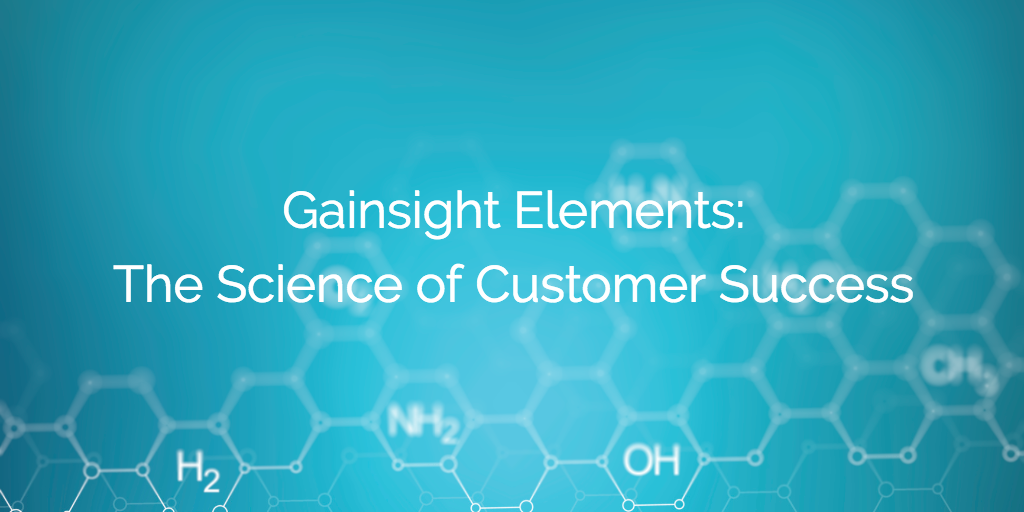Let me take you back to when I was 10 years old.

Yup, I rocked those bangs.
I was also super shy. I had an A+ average, but my teachers told my parents that I never participated. I was a great athlete, but I was nervous to go to soccer camp because it meant I’d have to meet new people. I had a tight circle of close friends, but even they sometimes wondered aloud what I was thinking about when I had that dream-like expression on the playground, since I didn’t typically share what was on my mind. I was generally anxious, and settled for being known as the “nice” person.
But it didn’t feel good. I felt bottled up, untrue to myself. And that didn’t serve my friends or community.
Things changed when my parents saw my fourth grade report card. All the scores were high except for “Participation.” Thinking that I had a lot more to contribute, my parents encouraged me to visit a new school, which happened to be an all-girls school. I came home from a day-long visit and sobbed.
“Mom, the girls are so mean there!”
“What happened?”
“They are loud. They talk constantly. They’re scary.”
“It sounds like they’re not mean. They’re just strong. You can be nice and strong at the same time.”
That statement—that you can be nice and strong at the same time—was a revelation to me.
Over the next five years, I underwent one of the greatest journeys of my life. My fellow students—who were boisterous, assertive, and funny—became my role models. Following in their footsteps, I won awards at Model United Nations debate conferences, which basically favored the loudest public speaker. I became captain of my lacrosse team and gave them motivational speeches. I even choreographed a dance with our Athletic Association and volunteered to be the lead dancer, which meant embarrassment in front of the entire student population. But I loved it.

Today, even people who know me well would be surprised to hear that I was shy at one point. They know me as an extrovert, an advocate for her beliefs, and a regular party-organizer. And the person who’s pushing for a provocative new way of doing things, even if it seems unrealistic at first.
Folks who know me now would still describe me as “nice.” But the word “brave” comes up, too—which is a small point of pride for me, given how far I’ve come.
Being “Nice” to Your Clients
I share this story because I see many Customer Success Managers out there trying to be “nice” to their clients. The personality they’re aiming to portray is:
- Good listener
- Attentive
- Receptive to feedback
- Contagiously positive
That’s a problem.
Here’s the client journey that “nice” produces:
- “I really like your team, so I bought your product.”
- “Then they asked me, what do you want to do in the product?”
- “I told them XYZ things. But to be honest with you, I had no idea if that was the right decision.”
- “Your team never pushed back.”
- “They kept asking me, what would you like to do next? I felt like I was the one pushing the process.”
- “We still haven’t gotten value.”
- “Truly what I wanted was for you to tell me what to do. You guys know best—I want to use the product the way your most successful clients do it.”
- “But now since we’re starting from a blank slate, this really just seems like a ‘build’ exercise, and IT says they can do it.”
- “My CFO is breathing down my neck about cutting costs, and I can’t defend this expense if I’m not getting value.”
- “This isn’t personal, though. You have great people.”
That’s the excruciating sound of a customer that’s about to churn. Because your team was too “nice.” And I’ve definitely had my share of painful conversations with customers like this one. While I wish I could say that a customer has never churned at Gainsight, that’s unfortunately not the case.
Now let’s say you have a brave team. They’re brave like Katniss and Peeta from Hunger Games. They’re rearing to tell clients what to do. They want to be “prescriptive.”

<span=”font-size: xx-small;”>Credit: Lionsgate Films
But they don’t know what to say. What is the right thing to do? They need a point of view that they can advocate. How do we try to solve this problem at Gainsight?
Gainsight is an incredibly flexible platform. The beauty is that you can build almost any customer success workflow in it. But that’s also the challenge—you can build anything—including a workflow that isn’t valuable for your team.
That’s why we’re excited to unveil our prescriptive methodology, Customer Success Elements.
Elements are Gainsight’s Solutions. What do I mean by Solution? Gainsight has a terrific platform. But in general, our clients don’t think about product features first; they think about the business challenges they have to solve. We need Solutions in order to map our product features to clients’ objectives.
Each Element is a prescriptive approach for combining people, process, and the Gainsight platform to solve Customer Success business challenges.
The Elements reflect our tried and tested approaches to running a Customer Success team and working with hundreds of other Customer Success teams over the past five years.
The Elements approach takes a point of view. If you’re a client, expect to be challenged by us. We’re still going to listen well, learn about your objectives, gain an understanding of what makes you unique. And we’re still going to bring cupcakes to meetings sometimes. But we’re also going to push back when we think you’re on the wrong path. That’s because we want to make your team massively successful.
I couldn’t be more excited to tell you about Elements. Here’s the story.
The Customer Success Maturity Curve
The story begins with a Maturity Curve for Customer Success teams. We’ve identified four stages of Customer Success maturity, below:
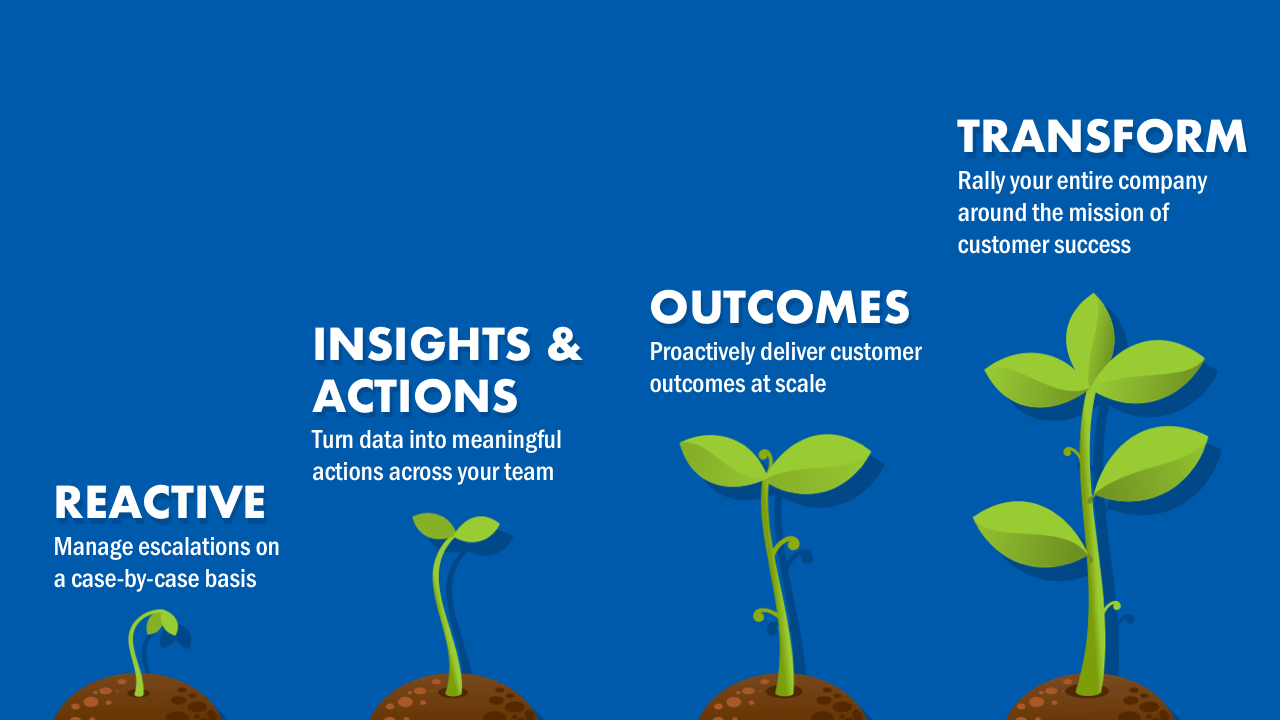
Naturally, our goal at Gainsight is to help our clients progress from stage to stage. Many companies come to us in the Reactive stage — firefighting mode. We aim to help them progress to the Insights & Actions stage, in which the client develops a broad view of client data and then takes action based on signals detected in the data.
But CS teams don’t simply want to be reactive to data—they want to be proactive (and prescriptive!) in driving outcomes for their clients, which is what the Outcomes stage is all about.
And finally, in the Transform stage, our clients strive to achieve the pinnacle of Customer Success maturity: creating a client-centric company culture and operations, orienting every department around client health. They’re involving their Services, Support, Product, and Finance teams.
The Periodic Table of CS Elements
The question is: How do we help our clients progress from stage to stage?
The unit for progressing from stage to stage is an Element. As a recap, Elements are Solutions—our prescriptive, best-practice approach to combining people, process, and the Gainsight platform to drive success for your clients.
Below is the Periodic Table of Customer Success Elements. (Of course, at Gainsight, we can’t help but use a geeky chemistry term!) You’ll see that the last three stages from the Maturity Curve are the headers at the top of the Table. (We don’t have Elements for the Reactive stage, because that’s Stage 0.) When we start working with clients, we ensure they’ve executed the Elements in Insights & Actions (Stage 1), and then we move on to the Outcomes stage (Stage 2), and ultimately the Transformation stage (Stage 3).
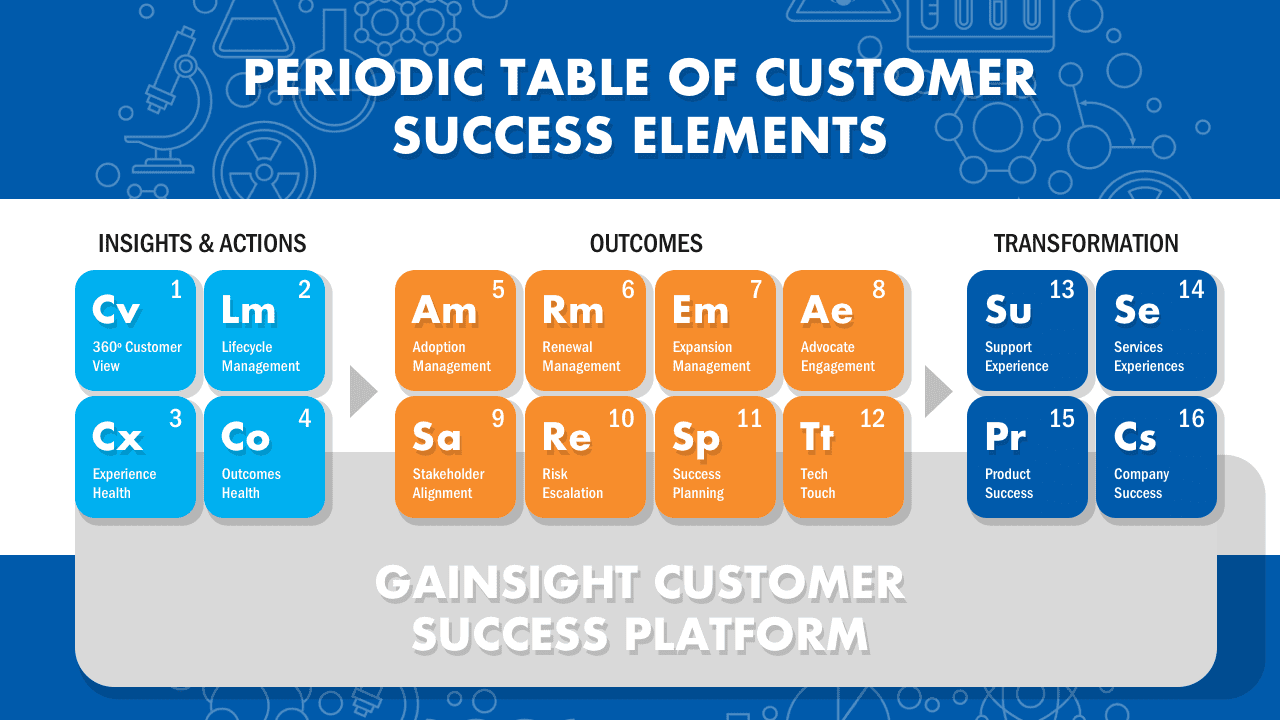
The Insights & Actions stage involves four Elements that are focused on gathering data about clients and taking actions based on that data. For example, in the Experience Health (CX) Element, we’re aiming to visualize the health of client interactions across the company, and follow up on our knowledge of that health.
The Outcomes stage requires collaboration across multiple CS departments. For example, in the Renewal Management (RM) Element, we’re aiming to consistently execute on renewals and develop informed forecasts, leveraging a partnership between CSMs and Account Managers. In the Tech Touch (TT) Element, a CS Operations or one-to-many leader aims to scale up the touch points over the customer journey with automation, supplementing the activities that the CSMs are performing. In the Advocate Engagement (AE) Element, a Customer Marketing leader seeks to translate the strong client outcomes that the CSM team generates into advocacy activities, such as references, referrals, case studies, and online testimonials.
The Transform stage involves even broader collaboration across the company, in service of the client. In Services Experience (SE), for example, a Professional Services team aims to move beyond a focus on utilization and P&L targets, to driving strong outcomes and experiences in client engagements. In Product Success (PR), Customer Success and Product teams work together to prioritize clients’ enhancement requests.
You may not have to implement all Elements in the Periodic Table. We recommend prioritizing these based on your objectives. And for some teams, it may make sense to skip ahead to some Elements in the Transform stage. But in general, we do recommend starting on the left and moving toward the right. (More about the evidence behind that recommendation in a section below.)
Objectives Precede Features
Each of these Elements uses a combination of Gainsight product features to achieve its goal. For example, Experience Health (CX) uses Surveys to gather data, Scorecard Measures to display the meaning of the data, Calls to Action to ensure that CSMs follow up on the data, and Dashboards to monitor effectiveness. Renewal Management (RM) uses Calls to Action and Playbooks to ensure that Account Managers send out paperwork to the client at the right time, Scorecard Measures to show the likelihood to renew, and Dashboards to forecast renewals. Each Element contains specifications for how to configure these features according to best practice.
We’re deliberately taking the approach of leading with client objectives, and positioning our product features as “servants” of those objectives. Here’s why.
Clients come to us expecting a “Customer Success Home Renovation.” They’ve seen photos on Pinterest illustrating a gorgeous beach home. They want a brand new kitchen with state-of-the-art equipment, and a living room with modern furniture.
What Chief Customer Officers don’t care about is the hammer, the screwdriver, or the drill. They expect Gainsight to be the General Contractor, handling the details. They expect that we’re using the best available tools; they want to make sure their team (e.g. the Gainsight administrator) loves the tools and believes in them. But what matters to the CCO is the outcome that the tools produce—i.e. the Customer Success Renovation.
With this in mind, we’re leading with the objectives—i.e. the Elements—and explaining how features serve those Elements.
The Evidence behind the Elements
We designed these Elements based on our experience working with many of you. But we also wanted to confirm that there was empirical evidence that demonstrates the impact of these Elements. So at our CCO Summit in February, we gathered survey responses from 100 Customer Success leaders, from a range of companies:
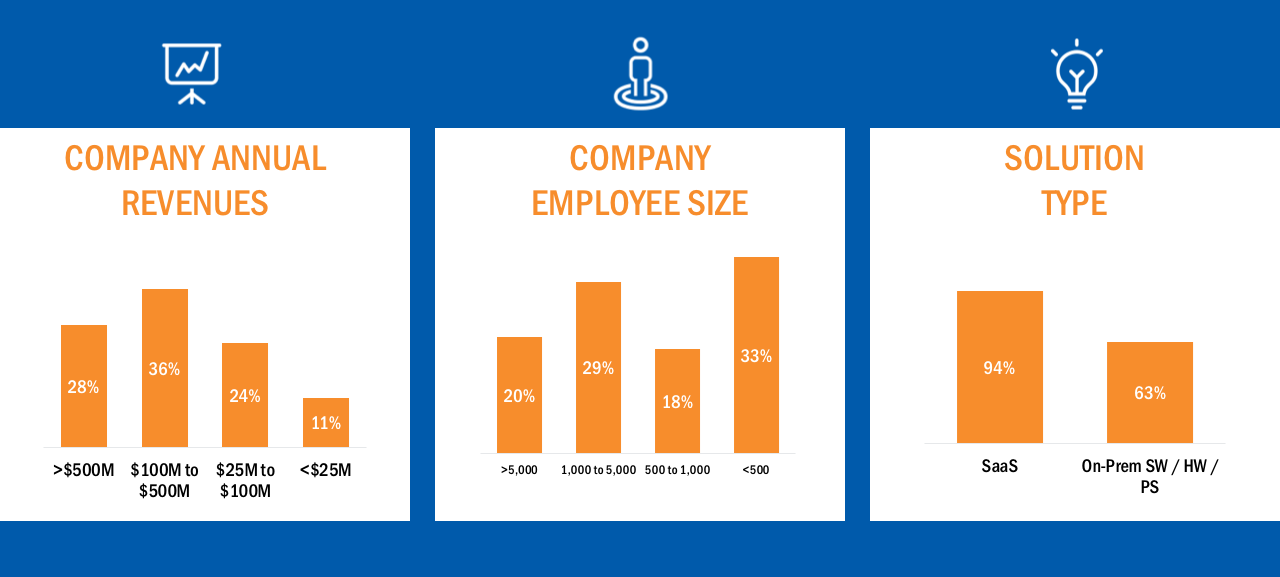
We asked, what’s your progress with each of the objectives represented by the Elements (options: Non-existent, Manual, Semi-Automated, Optimized)?

We produced a grid for each respondent that can be visualized this way:
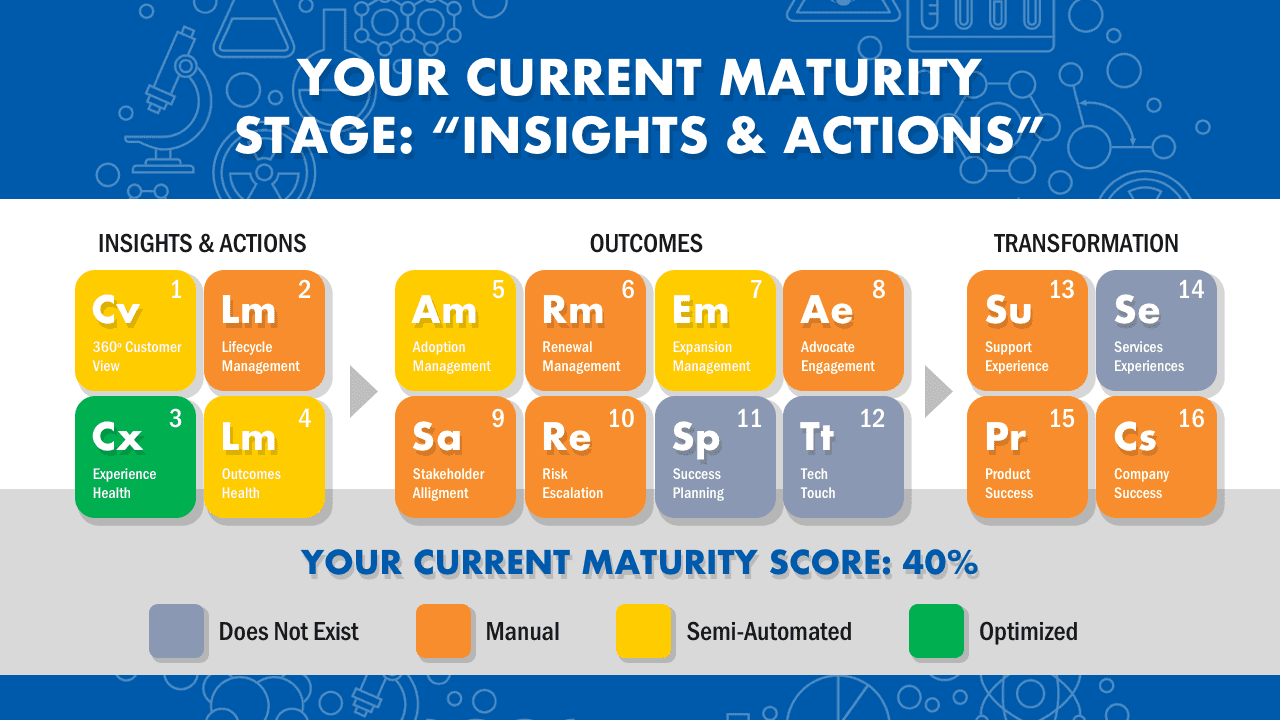
Then we grouped the respondents into the maturity stages, and we asked them for their Gross Retention Rate and Net Retention Rate. The results show a strong increase in Gross and Net Retention as companies progress along the Customer Success maturity curve.
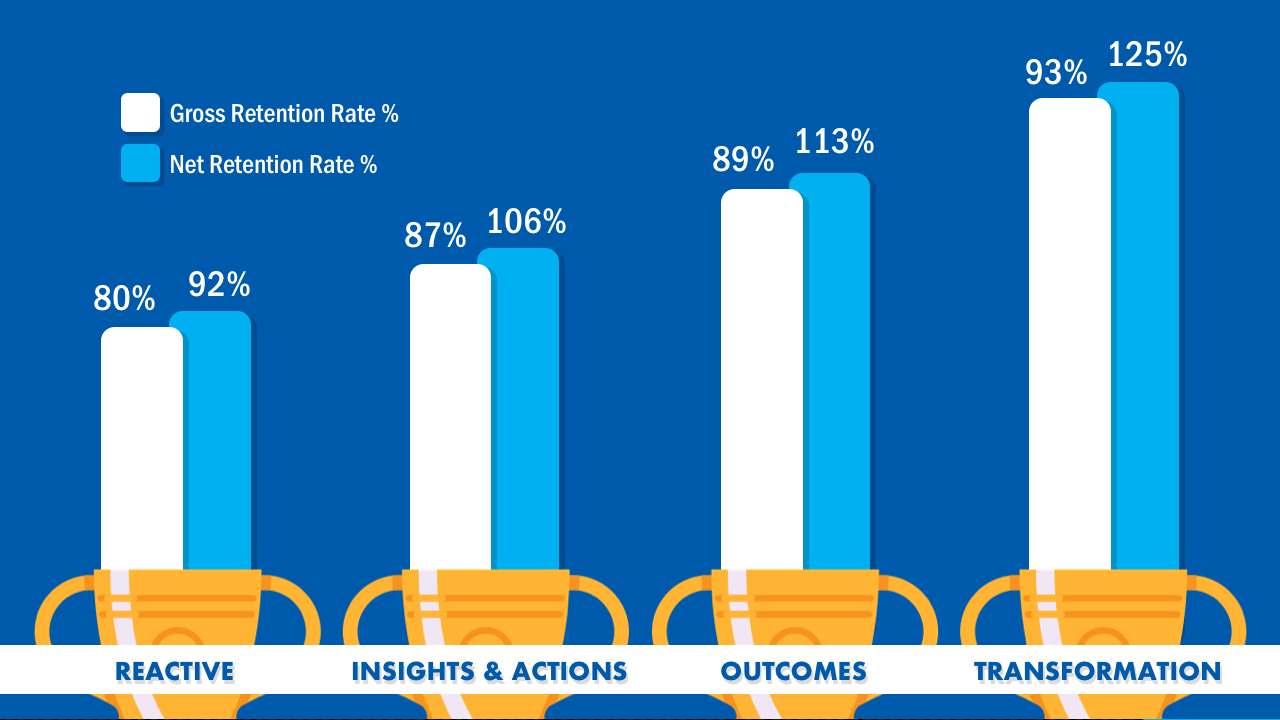
Some Elements individually were strongly correlated with increases in GRR and NRR. For example, progressing from “Does Not Exist” to “Optimized” in the Adoption Management Element on average is correlated with a 9% increase in Gross Retention. Progressing through the levels for Success Planning is correlated with a 29% increase in Net Retention.
Gross Retention:
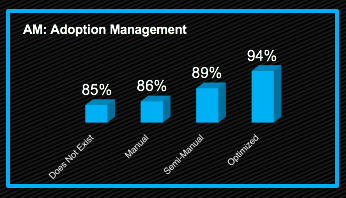
Net Retention:
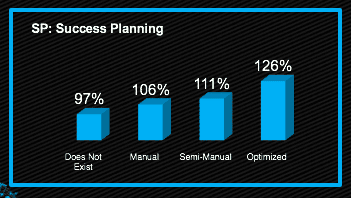
While Retention Rate is the flagship metric for many Customer Success teams, Elements are already driving strong results in other metrics as well. Brittany Habel, the CS Operations Manager at ServiceTitan, saw a 28 point increase in NPS when they began to emphasize the Adoption Management (AM) Element both internally and externally. “It made it easy for customers to see how their adoption was trending and correct any downticks before it became a bigger issue. Product adoption improved as did customer happiness, and we were also perceived as much more of a partner.”
Ben Michael, the Sr. Manager of Customer Success at Jamf, stated that the Renewal Management (RM) Element “helped us scale our renewal process dramatically. We’ve increased our on-time renewals by 10% and each rep is able to handle 50% more renewals than before.”
In the future, we’ll be tracking the impact of Elements on our clients using an ROI Scorecard, as part of our own internal implementation of the CO (Outcomes Health) Element. Each Element has standard metrics that measure its ROI.
How We’re Using Elements Internally
The Periodic Table of CS Elements is not a “post-sales” concept. We’re using it across our entire company, so that our clients benefit from a consistent experience across their journey with us: from the time they find out about Gainsight, to when they visit our website, to when they speak with a sales person, to when they implement our product.
You might be looking to launch your own version of a Maturity Curve and “Periodic Table” to better serve your clients. When you do this, consider working with other departments to launch a company-wide initiative to ensure that these concepts are used across functions. As an example, here’s how we explained the benefits of Elements for each department, during our company kickoff earlier this year.
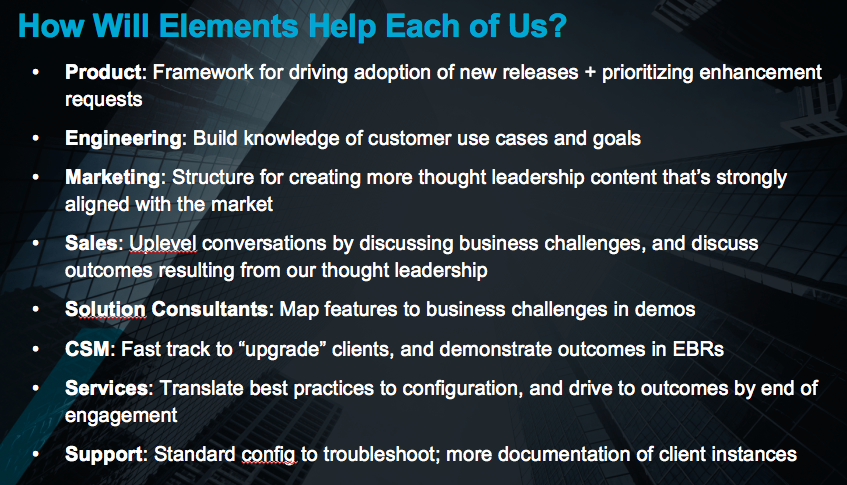
Being Brave
The story isn’t over for us at Gainsight. We’re not 100% prescriptive yet. We have our “point of view” now. But communicating it will take bravery.
For me, being brave means subduing in my mind all the messages I tell myself about how I’m not good enough. From the time we are little, we hear messages from all around us that disempower us. Messages such as:
- Nice girls don’t get angry
- Strong boys aren’t artistic
- It’s weak to cry
- Get in line
- That startup job is too risky
- You should own a home at this point
- You should have made more money by this point
- You should be spending more time with your kids
- You haven’t made it far enough
We also hear messages about how exerting power—even if it’s done bravely—is inherently bad. We hear about how “power corrupts,” about celebrity take-downs. Even the blockchain movement—of which I am a passionate supporter—is often focused on removing power wherever it is.
But I’ll say that power can be applied for good or for evil. I think that if our Gainsight team can be a bit braver, we can create even more good for our clients.
I imagine your business, too, can create good for your clients.
So how will you be brave this year?
How Do I Learn More?
If you’d like to learn more about Elements, consider these steps:
- Get a maturity assessment. We’ll show you where you are on the Maturity Curve, and which Elements you should focus on. Contact us at demo@gainsight.com.
- Check out our website on Elements here.
- Listen to our upcoming Season 2 of The Customer Success Podcast.
- If you’re a client, talk to your Gainsight Client Outcomes Manager (which is our title for CSM) about enrolling in the Elements Program.
Special thanks to the many Gainsters who contributed to this initiative!
